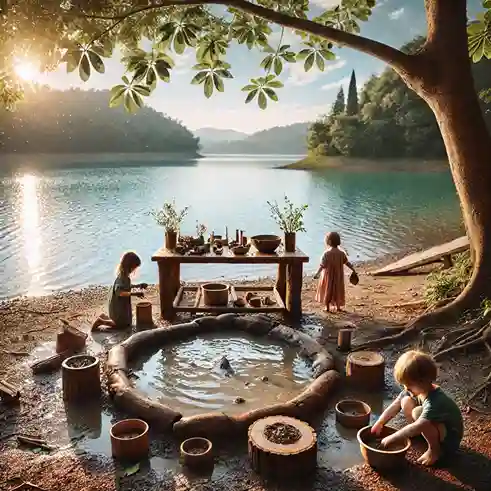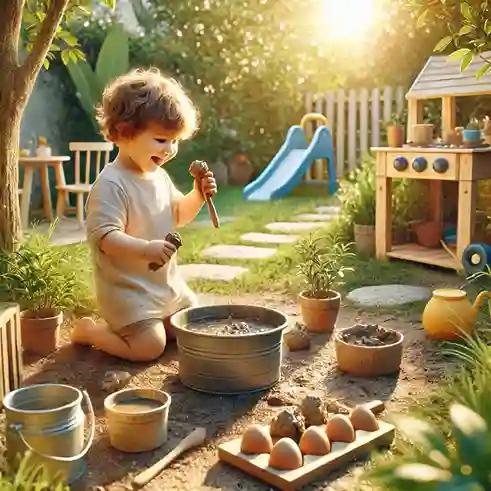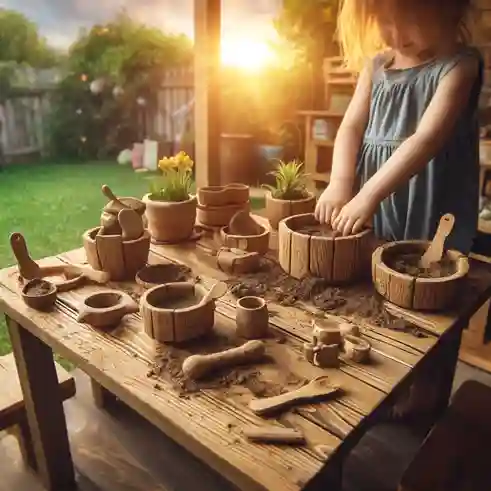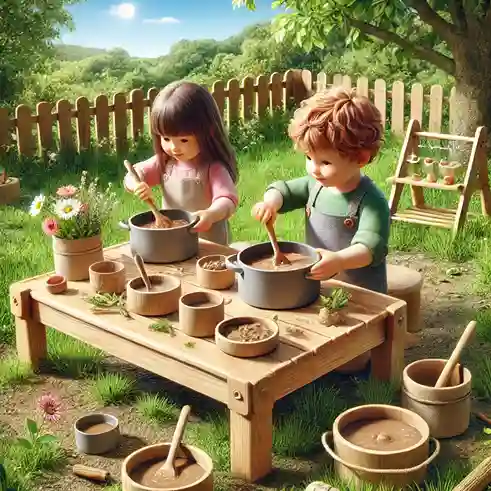What is a Mud Kitchen for kids, and what’s the connection with children? – Ultimate Guide
Our society nowadays has accepted the idea of a mud kitchen as an invaluable element to the children’s playgrounds that helps in developing young minds while encouraging effective use of resources. A muddy kitchen is defined as an outdoor place in which children could engage in purposeful play with materials that include clay, water, some organic matter, and even different types of tools. In essence, a mud kitchen is a space where children are ‘cooking’ with the intention of creating things they imagine.
All the benefits that come with mud kitchens have made children in this relatively short period of time love them dearly. Engagement in outdoor activities fosters children’s sensory perception of the environment. The activity of squeezing, mixing, and molding helps with motor skill development, while simultaneously boosting imagination. Indeed, most children would prefer to engage in play that is messy and provides them with the opportunity to explore and be creative. So-called “messy play” allows children to put their imagination to work, enabling them to understand the world and learn better.
Additionally, mud kitchens spur creativity while children are playing by enabling them to come up with different stories when they are with their peers. Children can also engage in parallel play since it enables them to freely use materials together, thus improving their socialization skills. Moreover, outdoor activities as a whole promote a variety of elements of physical wellness because children are encouraged to participate and be active, improving their gross motor skills and self esteem. For this reason, these particular pieces of muddle kitchens equipment should be placed in the outdoor play areas to make children happy and enable them to achieve some developmental milestones.
Benefits of Outdoor Play
There is a plethora of benefits to outdoor activities and it greatly helps with the development aspect of a child. In this case, outdoor activities should not be set to only physical activities for children because there are numerous other benefits. With regard to mud kitchens, these help in having children engage with different kinds of sensory experience from as early as possible which is critical for development. The feel, odor, and sight of mud and other organic materials that children interact with as well as the texture serve as a building block from where they can actively engage and form thoughts about the world around them.
Children mix water with mud or even clay which enables them to make different structures and develop their motor skills. Their coordination and fine motor skills also improve as they mix, pour, scoop, and sculpt. Typically, mud or clay activities are done using small tools which helps to develop hand strength and hand skill. These are important skills for children to possess at an early age because they need them for activities such as writing and personal grooming. In addition, these mud kitchens enhances the children’s role play activity which nurtures their imagination and creativity as well as storytelling skills.
At a glance, one may think that sand and water play are purely recreational activities. However, they significantly enhance the child’s social interactions. With the help of a mud kitchen, children are able to improve social interactions outdoors. Such activities inspire children to participate more which in turn increases their communication and teamwork skills. Children are also able to negotiate while sharing tools and equipment. Effective empathy will gradually form as children learn to appreciate what their peers are going through. These social interactions, however, play a vital role in helping the children learn social concepts such as how to manage relationships and deal with conflict.
Broadly speaking, children’s outdoor play is enhanced through mud kitchens because children are able to undertake tasks that enhance their physical, social, and cognitive development. On the other hand, mud kitchens provide children with a variety of important skills that range from fine motor skills to more social type of skills, including elements of perceiving.

What Is A Mud Kitchen for kids Made Of?
In terms of a child’s creative capacity, the design of a Mud Kitchen is as open as it is furnished. Arguably, the most significant and obvious feature of a mud kitchen is the mud itself. This mud can be purchased or sourced from the backyard. Kids love to play with mud and get dirty, and there is no shortage of how many types of different muds kids can experience. For example, children will adore the texture of mud, how it feels, and even how it changes when water is added to it. When mixed with other art materials, the creative possibilities are endless with mud.
Water is also an essential ingredient for a mud kitchen. Water enables children to explore the possibilities of varying amounts of mud, and due to its lack of viscosity, serves as a great sensory tool. With such an ease of simply adjusting the amount of water, children can go from combining thick oily substances to mixing with thin lil watery mud, which happens to serve a variety of uses, those inintegrated to different forms of deep play. Such forms of potentiated integration are crucial to children as it allows them to further dive into scientific and sensory exploration.
Since kids enjoy various methods of mud cooking, even the software and gadgets improve the effectiveness of their experience. In fact, basic accessories such as pots, pans, spoons, or even measuring cups can add a touch of creativity to the kitchen setting. It is rather true that children’s imaginative role play is sparked when they ‘serve’ and ‘cook’ mud dishes. In addition to this, the imaginary scope of playing can be further increased by incorporating more natural resources like leaves, sticks, and stones. It indeed makes the experience of cooking in mud kitchens more intriguing and provides children with multi-sensory opportunities.
Besides the accessories and tools, the mud kitchen itself has to be well designed. This also helps in being more versatile in different types of outdoor areas such as small backyard houses or large private or public parks. For instance, the design can shift quite significantly and hence supports customizability. The construction can be done using old wooden pallets or hand made from scratch. By changing some elements with regards to the space in hand, families and teachers can set up a mud kitchen that is useful, fun, and appropriate for outdoor activities.
Constructing a Mud Kitchen in the Back Yard
To start with, a mud kitchen built outside a house is a very useful piece of equipment because not only does it let a child to engage in various activities, it also helps boost imagination. The first step is to look for a suitable place outdoors that is accessible and is ideally situated close to the water tap. The location can be anywhere within the child safety area of your backyard, garden, or even patio because it is somewhere children will be allowed to play and explore without worrying about getting dirty.
Building a muddy kitchen would be easier if you already know which spot to locate the kitchen. You need to make sure that all the appropriate materials are gathered all together when making or assembling the kitchen. The older cooking pieces such as the pots, pans, or containers will not only serve as decoration but also can be used to beautify the area while ensuring the principles of sustainable development. Children will have a lot more fun if they are able to combine traditional rocks, sticks, leaves, and dirt with Lego, as it will enhance their level of creativity. These rough weather resistant serving homemade tables are perfect for little cooks as they can use it as a platform for their artistic creativity using mud.
A parent’s primary concern when creating a mud kitchen should always be the wellbeing of the child Kicking things off, it is a good practice to clear away any potentially harmful materials such as sharp objects. Besides, including a designated area for children to wash themselves is equally as important before and after the mud play for use during hygiene purposes. With that put aside, the aid of a hose pipe and a water bucket can assist children in scrubbing themselves with ease while helping prepare the preferred mud texture. While children are at play, care should be taken to watch them inorder to make sure that these children do not get hurt while exploring the new environment.
At this point children should at least be worked attaching the area which is the mud kitchen. what is a mud kitchen for kids should allow children to feel attached to it therefore you should permit them to add things that they would be family with. A child’s version of a basic kitchen will become a magical place where culinary dreams come to life. In addition, these initiatives make children adore nature even more because it nurtures imagination while teaching them outdoor.

Make Learning Part Of Playing!: what is a mud kitchen for kids
Toddlers, even older elementary kids can now engage in ‘cooking’ with this creative what is a mud kitchen for kids and pick up the science and mathematics education with their ‘eye goggling’ imagination. Taking this new approach to a what is a mud kitchen for kids has definitely made cleaning up the kitchen a lot easier. Even in their imaginative play settings, kids learning these productivity skills is a really good thing. More so with putting ‘cooking’ in styled inverted commas what is a mud kitchen for kids comes as a great asset for children to learn about environmental surroundings and gaining scientific knowledge.
Now children can perform scientific experiments in a what is a mud kitchen for kids. Mixing sand, water and other natural ingredients will help them explore new textures, colors, and consistencies. These experiments give children an exciting way to learn basic measurement and mixing concepts. For example, when a child stirs in mud, water is added to the mud, and it’s viscosity decreases. Demonstrating the first state of matter and the child is introduced to the concept of gaining matter versus losing matter.
Lastly, children can also enhance their math skills further through the use of what is a mud kitchen for kids. Kids can count and measure how much mud they can scoop, pour, or squeeze into different molds. Children can even prompt their colleagues to use their creativity by challenging them to mold the mud into exciting objects, then go ahead and have fun while aiding the guardians who do not have any imagination.
Outdoor activities that are directed towards environmental sensibility give learners an opportunity to score on several learning activities at the same time. While playing, children can try and appreciate the essence of natural resources such as disposables and try to learn the impact of weather on the ecosystem. In turn, children appreciate the environment, and start becoming stewards of nature. Actually, children begin to nurture positive things that actually we call the care for the Mother Nature. After all, children begin to nurture positive concepts that actually revolve around caring for Mother Nature. Thus, what is a mud kitchen for kids are very useful in teaching young children because they make learning very amusing and throwing mud at the same time.
What is a mud kitchen for kids: Encouraging Creative Play
Children’s development, including their creativity, is largely influenced by how imagination is encouraged during mud play. what is a mud kitchen for kids is a perfect example of a free play material that does too much because it allows unrestricted play. Children imitate and portray constructive active roles like in storytelling, drawing, and even acting. All these types of play are vital for growth and development of children.
The caregivers of young children can make different types of a what is a mud kitchen for kids geared towards different styles of play. For example, “chefs” or “kitchen owners” can be engaged in role-plays to cook for grand meals using mud, leaves and water. This type of role-play enables them to socialize better because it gives opportunity to children to make pretend stories based on the food they cooked. To further promote engagement while they are in role play, more realistic kitchen items, containers, and plants can be used.
Also, children can be guided to take advantage of their imagination and natural creativity by sculpting and painting with muds. For example, sculpturing mud into their much loved characters or shapes from a story. Such an activity encourages imaginative play and entertains children with colors and textures while improving motor skills. All other activities from sculpting mudpis of animals to building tiny ecosystems helps them love nature more.
You can invoke pretend play by creating dress up play scenarios, say acting out the Three Little Pigs. This aids children to enact the story using different props from the what is a mud kitchen for kids and encourages them to use the outdoor what is a mud kitchen for kids without inhibitions.

What is a mud kitchen for kids: Safety Measures
Sensory outdoor what is a mud kitchen for kids are really engaging ways of getting a child’s attention. But it is very important that the child is safe in these types of places. One of the major safety issues is what type of mud, and other natural elements, goes into the kitchen. Considering what children come into contact with, soil that does not have chemical fertilizers or even pesticides would be cleaner. Furthermore, non sharp leaves and small stones can be put in the sand since they are safe to touch and would make the playground more enjoyable.
Perhaps the next concern is supervision. An adult needs to be there all the time the child is playing with the what is a mud kitchen for kids mockup. This is to aid them in understanding certain rules, such as how mud or anything else they may wish to gnaw on should not eaten. It is also more stimulating for children when they are able to engage in social interactivity while still having supervision. To a certain extent, it is exceedingly valuable to state what is a mud kitchen for kids is and is not designed for, in order to promote imaginative use of the toy while ensuring a level of safety.
Additionally, everyone should pay close attention to any possible allergies or sensitivity concerns. Some children might have allergies for some particular kinds of soil, plants, or even other things that are used in the what is a mud kitchen for kids. This should be verified from the parents or guardians before these things are brought in. However, by simply watching the kid play allows the caregiver to mitigate the possible reactions that could ensue. Keeping in mind that the ideal what is a mud kitchen for kids does not pose a danger; these indeed would be regarderd as safe and enjoyable place of learning that inspire the children to engage in creative play.
Adventures outside the classroom do exist in a mud kitchen
The joy and excitement that children experience towards what is a mud kitchen for kids can be demonstrated through various real life situations in regards to the value of outdoor play. One parent recounted memories of her children aged four and six years using their imaginative skills yet again this time in their backyard kitchen. They acted as chefs with a pot and spoon making everything from mud pies to leaf and stone ‘soup’. The kids’ liveliness depicted how social solo role play vivid imagination brings them joy as in the process they also get to engage in self driven role play.
Moreover, a few of the educators reported that children were able to benefit a lot from the what is a mud kitchen for kids while learning these activities. For instance, one teacher noted that the child was most engaged when he was able to dig and find the different clay shaped mud pieces he had created in his imagination. Additionally, as children donned their caps, it was not only them who were allowed to use their imagination, but it also gave them the chance to think of different things which can be added to nature.
Furthermore, it can be inferred from parents’ opinions that what is a mud kitchen for kids transform outdoor seeking activities. One parent reported that his son, who rather kept to himself during group work, began to participate more when other kids were active in the what is a mud kitchen for kids. He was able to engage in solo creative play that’s where he gained social interaction and learned how to make friends. It enables children, to some extent, to learn and grow in a social context.
Children fully enjoy these outdoor learning experiences. Nature and the environment will let children have more beautiful and entertaining childhood experiences.
Can Mud Kitchens Make a Difference?
All the aforementioned ideas bring us to the fact that what is a mud kitchen for kids are beneficial to children in terms of creative and sensory play. Using natural materials for play is one form of constructive activities that children of preschool age need to develop problem solving, collaborative, and psychomotor skills. This kind of play greatly benefits children’s holistic development and well-being and what is a mud kitchen for kids helps children to do so.
what is a mud kitchen for kids are very important in developing an appreciation for the surroundings which is vital for outdoor play. These activities are also beneficial for children’s mental and emotional growth as well as their social development through pretend play with other kids. Kids practice doing things together with juniors that support them in learning the most fundamental communication and negotiation skills necessary for social development in a what is a mud kitchen for kids.
Gilbert and Tafa also observe that the design of outdoor areas such as what is a mud kitchen for kids makes it possible for parents and teachers to enhance happiness and development in children. Such spaces enable children’s involvement in pretend play, which fosters coping skills and adaptive behavior. These benefits are evident when children are allowed to move freely and actively construct their own identities which the child learns to take risks, explore, play and experiment.
To sum up, the construction of what is a mud kitchen for kids is not purely the construction of a setting to play, it augurs well for the broader investment of a child’s holistic development. what is a mud kitchen for kids are indeed places children can have fun, though their benefit extends further as they stand to foster new skills and emotional development. With the use of what is a mud kitchen for kids, children’s appreciation of their childhood and the real life skills that they need gaining is a given.

